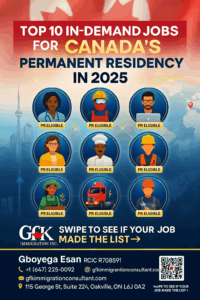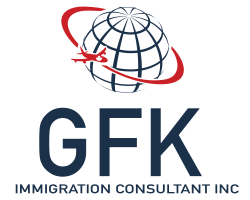
Top 10 In-Demand Jobs For Canada’s Permanent Residency In 2025
Canada’s job market in 2025 is offering opportunities for skilled workers, especially those eyeing permanent residency (PR) through Express Entry or seeking spousal open work permits (SOWPs).
With job vacancies shrinking to 500,000 nationwide, specific sectors are crying out for talent, offering pathways to permanent residency and work opportunities.
This comprehensive guide dives into the most in-demand jobs and sectors, National Occupational Classification (NOC) codes, and strategies to maximize your immigration success, backed by the latest Statistics Canada data from 2025.
Table of Contents
Whether you’re a healthcare professional, tradesprson, or seeking spousal work options, this article is your roadmap to thriving in the dynamic Canadian labour market.
Why Canada’s Job Market is a Goldmine for Immigrants in 2025
Canada’s economy relies heavily on skilled immigrants to fill critical labour shortages, particularly in healthcare, construction, and other high-demand sectors.
The Express Entry system, a cornerstone of the Canadian immigration framework, prioritizes candidates with experience in these fields through category-based draws.
These draws target specific occupations, increasing your chances of receiving an Invitation to Apply (ITA) for PR, even with a lower Comprehensive Ranking System (CRS) score.
Additionally, spouses of workers in certain Training, Education, Experience, and Responsibilities (TEER) 2 and 3 occupations can apply for an open work permit, enabling them to work in Canada without a specific job offer.
According to Statistics Canada’s latest report, Canada’s job vacancy rate stood at 2.8% in April 2025, the lowest since October 2017, with 501,300 unfilled positions.
Despite this dip, sectors like healthcare and construction remain desperate for workers, offering fertile ground for immigrants.
This article lists the top in-demand sectors, eligible occupations for Express Entry, and SOWP opportunities, providing actionable insights to help you and your spouse navigate the Canadian immigration and job landscape.
You may also like: $250 U.S. Visa Integrity Fee Shocks Canadian Permanent Residents: What It Means for You
Canada’s Top In-Demand Sectors in 2025
Statistics Canada’s data highlights three sectors with the highest job vacancy rates, signalling robust demand for skilled workers.
These sectors align closely with Express Entry’s category-based draws and SOWP eligibility, making them prime targets for immigration hopefuls.
Healthcare and Social Assistance (4.1% Vacancy Rate)
The healthcare sector leads with a 4.1% vacancy rate, driven by an aging population and rising demand for medical services.
Roles like registered nurses, medical technologists, and social workers are in short supply, with provinces like Ontario and British Columbia actively recruiting through Provincial Nominee Programs (PNPs).
Accommodation and Food Services (4% Vacancy Rate)
This sector faces persistent labour shortages, particularly for cooks and butchers.
While these roles qualify for Express Entry category-based draws, they do not currently support SOWP eligibility, making them less versatile for families.
Construction/Trades (3.2% Vacancy Rate)
The Canadian construction boom, fueled by infrastructure projects and housing needs, has created a high demand for tradespeople like carpenters, electricians, and plumbers.
The federal government’s commitment to admitting 14,000 foreign construction
orkers in 2025 underscores this sector’s priority.
Low-demand sectors, with vacancy rates below 2%, offer fewer opportunities and are less likely to qualify for category-based draws or SOWPs.
Focusing on high-demand sectors maximizes your immigration and employment prospects.
Express Entry Category-Based Draws: Your Fast Track to Canada PR
Express Entry is Canada’s flagship immigration system, managing applications for the Federal Skilled Worker Program (FSWP), Federal Skilled Trades Program (FSTP), and Canadian Experience Class (CEC).
Category-based draws, introduced to address labour shortages, target candidates with at least six months of continuous, full-time work experience in specific high-demand occupations within the past three years.
These draws prioritize skills over CRS scores, making them a game-changer for applicants.
To qualify, you must:
- Have a profile in the Express Entry pool.
- Meet the minimum criteria for one of the three federal programs.
- Possess six months of continuous work experience (in Canada or abroad) in an eligible NOC code.
Below, we break down the top in-demand occupations eligible for category-based draws, organized by sector, with their corresponding NOC codes.
Healthcare and Social Service Occupations
The healthcare sector dominates Express Entry’s category-based draws, reflecting Canada’s urgent need for medical professionals.
In 2025, 3 draws issued 5,000 ITAs for healthcare and social services roles, signalling strong federal focus.
Eligible occupations include:
-
- Registered Nurses and Registered Psychiatric Nurses (NOC 31301): Critical in hospitals and clinics, with high demand in provinces like Manitoba and Quebec.
- Licensed Practical Nurses (NOC 32101): Support roles in patient care, especially in long-term care facilities.
- Medical Laboratory Technologists (NOC 32120): Essential for diagnostics, with opportunities in urban and rural settings.
- Physicians (NOC 31102, 31100, 31101): General practitioners and specialists are in short supply, particularly in remote areas.
- Nurse Aides, Orderlies, and Patient Service Associates (NOC 33102): High demand in eldercare, with entry-level opportunities.
- Pharmacists (NOC 31120): Needed in community and hospital settings.
- Social Workers (NOC 41300): Increasingly targeted for mental health and community support roles.
- Veterinarians (NOC 31103): In demand due to growing pet care needs.
- Other Roles: Includes audiologists (NOC 31112), physiotherapists (NOC 31202), and occupational therapists (NOC 31203).
These roles align with Canada’s aging population and expanding healthcare infrastructure, offering stable career paths and immigration opportunities.
Construction and Trades Occupations
The trades category, expanded in February 2025 with 19 new occupations, is a cornerstone of Canada’s immigration strategy.
With a 3.2% vacancy rate, trades roles are critical for infrastructure and housing projects.
Eligible occupations include:
-
- Carpenters (NOC 72310): High demand in residential and commercial construction.
- Electricians (NOC 72200, 72201): Industrial and residential electricians are sought after, with opportunities at employers like Parks Canada and Hershey.
- Plumbers (NOC 72300): Essential for new builds and renovations.
- Welders and Related Machine Operators (NOC 72106): Needed in manufacturing and construction.
- Construction Managers (NOC 70010): Supervisory roles with strong PR prospects.
- Heavy-Duty Equipment Mechanics (NOC 72401): Critical for construction and mining industries.
- Other Trades: Includes bricklayers (NOC 72320), machinists (NOC 72100), and heating/refrigeration mechanics (NOC 72402).
Spousal Open Work Permits: Opportunities for Your Partner
SOWPs allow spouses or common-law partners of certain workers to work for any employer in Canada, providing financial flexibility for immigrating families.
Eligibility depends on the principal applicant’s occupation and work permit type.
In 2025, SOWPs are available for spouses of workers in:
- TEER 0 or 1 Occupations: Management and professional roles, such as physicians or engineers.
- Select TEER 2 and 3 Occupations: Limited to healthcare and construction/trades sectors.
Eligible Healthcare Occupations for SOWPs
TEER 2 roles:
- Licensed Practical Nurses (NOC 32101): High demand in long-term care.
- Medical Laboratory Technologists (NOC 32120): Critical for diagnostics.
- Pharmacy Technicians (NOC 32124): Needed in retail and hospital pharmacies.
- Animal Health Technologists (NOC 32104): Growing demand in veterinary clinics.
TEER 3 roles:
- Nurse Aides, Orderlies, and Patient Service Associates (NOC 33102): Entry-level roles with strong demand.
- Medical Laboratory Assistants (NOC 33101): Support roles in diagnostics.
- Dental Assistants (NOC 33100): Needed in dental clinics.
Eligible Construction/Trades Occupations for SOWPs
TEER 2 roles:
-
- Carpenters (NOC 72310): High demand in housing projects.
- Electricians (NOC 72200, 72201): Opportunities in residential and industrial settings.
- Plumbers (NOC 72300): Essential for infrastructure development.
- Construction Supervisors (NOC 72010–72014): Leadership roles with strong PR prospects.
TEER 3 roles:
- Transport Truck Drivers (NOC 73300): Vital for logistics, though less prioritized in 2025.
- Heavy Equipment Operators (NOC 73400): Needed for large-scale projects.
- Concrete Finishers (NOC 73100): High demand in construction.
Notably, spouses of workers in accommodation and food services (e.g., cooks, butchers) are not eligible for SOWPs, making healthcare and trades more attractive for families.
You may also like: Canadian Benefits August 2025: Unlock Thousands in Tax-Free Cash to Beat Rising Costs
To apply for an SOWP, the principal applicant must hold a valid work permit (e.g., based on a Labour Market Impact Assessment or international agreement) and be employed in an eligible occupation.
The spouse must provide proof of relationship and meet general work permit requirements, such as health and security checks.
Job Vacancy Rates by Province: Where to Find Opportunities
Canada’s job vacancy rates vary by province, influencing employment and immigration prospects.
The highest vacancy rates are:
- Manitoba (3.3%): Strong demand for healthcare and trades workers, with targeted PNP draws for nurses and carpenters.
- Saskatchewan (3.3%): Opportunities in healthcare, construction, and agriculture.
- British Columbia (3.1%): High demand for trades and tech roles, with over 1 million job openings projected by 2032.
- Quebec (3.1%): Focus on healthcare and Francophone candidates, with unique immigration pathways.
Provinces with lower vacancy rates, such as Newfoundland and Labrador (2.1%) and Ontario (2.5%), offer fewer opportunities, particularly in oversubscribed sectors.
Targeting high-vacancy provinces increases your chances of securing a job and PR.
Federal and Provincial Immigration Priorities
Canada’s immigration policies in 2025 emphasize healthcare and trades, aligning with labour market needs.
Key developments include:
-
- Express Entry Restructuring: In February 2025, the trades category expanded to include 19 new occupations, reflecting Canada’s infrastructure goals. Healthcare and social services remain top priorities, with 1,000 ITAs issued in 2025 draws.
- Construction Sector Boost: Former Immigration Minister Marc Miller announced plans to admit 14,000 foreign construction workers, addressing housing and infrastructure shortages.
- Provincial Nominee Programs (PNPs): Provinces like Manitoba and British Columbia prioritize healthcare and trades workers, with tightened eligibility criteria to focus on in-demand sectors.
- Francophone Immigration: Candidates with strong French proficiency are prioritized, especially outside Quebec, with CRS scores as low as 388 in recent draws.
These policies underscore Canada’s commitment to filling labour gaps through targeted immigration, making 2025 an ideal time for skilled workers to apply.
Strategies to Maximize Your Immigration Success
To leverage Canada’s in-demand jobs and immigration pathways, follow these steps:
-
- Target Eligible Occupations: Focus on healthcare and trades roles listed above, ensuring your work experience matches the NOC code requirements.
- Build Relevant Experience: Gain at least six months of continuous, full-time work experience in an eligible occupation within the past three years.
- Create an Express Entry Profile: Submit a profile under FSWP, FSTP, or CEC, ensuring accuracy in NOC code selection.
- Enhance Your CRS Score: Improve language proficiency (e.g., IELTS, TEF), gain Canadian work experience, or secure a provincial nomination.
- Explore PNPs: Apply for provincial nominations in high-vacancy provinces like Manitoba or British Columbia, which offer additional CRS points.
- Verify SOWP Eligibility: If relocating with a spouse, ensure your occupation qualifies for an SOWP, prioritizing healthcare or trades roles.
- Monitor Job Vacancies: Use platforms like Canada Job Bank, Indeed, and LinkedIn to find openings in high-demand sectors.
- Prepare Credentials: Get your education and work experience assessed through organizations like World Education Services (WES).
- Stay Updated: Follow IRCC announcements and provincial immigration updates to align with the latest draws and policies.
Why Act Now?
The Canadian 2025 Immigration Levels Plan, introduced under former Minister Marc Miller, targets 395,000 newcomers, with a focus on economic immigration.
Despite a 20% cut in PR admissions, skilled workers in healthcare and trades remain in high demand.
The unemployment-to-vacancy ratio of 3.1:1 indicates a competitive but opportunity-rich market, especially in high-vacancy provinces.
For families, SOWPs offer a dual-income pathway, enhancing financial stability while pursuing PR.
With provinces tightening PNP criteria and federal draws prioritizing in-demand sectors, aligning your skills with Canada’s needs is critical.
Canada’s job market in 2025 is a beacon for skilled workers worldwide, with healthcare and construction leading the charge.
By targeting in-demand occupations, leveraging Express Entry category-based draws, and exploring SOWP options, you can fast-track your journey to PR and build a stable future for your family.
Use this guide to identify eligible roles, align your experience, and stay ahead in Canada’s competitive immigration landscape.
Ready to take the first step? Research job openings, create your Express Entry profile, and connect with immigration experts to make your Canadian dream a reality.
